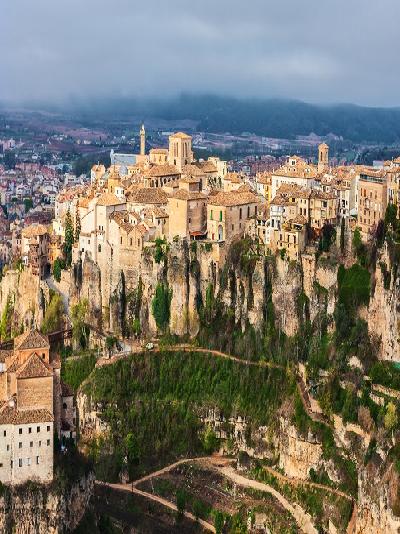 Cuenca is not just a medieval museum. It is the capital of the province of the same name, belonging to the autonomous community of Castilla la Mancha.
Cuenca is not just a medieval museum. It is the capital of the province of the same name, belonging to the autonomous community of Castilla la Mancha.
The city is unique because of its location: it is located on a hill in the middle of a deep gorge. On both sides of the strange rocks they are washed by the Houcar and Huecar rivers.
According to historians, Cuenca was founded at the beginning of our era. At that time, this place was inhabited by the ancient Celts, who chose it for its good location. From the height of the rocks there was an excellent view of the surroundings, and the enemy could not go unnoticed.
Over time, the city was conquered by the Arabs who gave it its name, and in 1177 the Christians led by Alfonso VIII joined Cuenca. Therefore, like many Spanish cities, it represents a combination of different architectural styles. In its long history, the city has experienced ups and downs.
In the 16th century, it experienced a plague epidemic. Then there were natural disasters, religious conflicts and economic crises.
But in the 20th century, Cuenca began to be visited by tourists, which was the beginning of development. Since 1996, it has been a unique place under the protection of UNESCO.
Cuenca Cathedral:
The Cathedral, built in 1196. The ancient temple, made in various styles, has been rebuilt several times, but is still considered unfinished.
Jesus' most sacred heart:
A modern monument erected as early as the 20th century, which is installed on a pedestal at the highest point of the city on the Sierra del Socorro hill.
Main Square:
The Plaza Mayor is the central square of the city. The most interesting building is the Baroque town hall, built in the second half of the 18th century. The main street that leads to the plaza is Alfonso VIII. It was architecturally formed in the 18th century and contains several beautiful historical buildings.
Historical Archive:
The Cuenca Historical Archive is the old building of the Spanish Inquisition Court.
Bridge of San Pablo:
This bridge usually offers the best views of Cuenca.
Old convent of San Pablo:
In a picturesque place on the Huecar gorge (in front of the hanging houses) is the old San Pablo Monastery, converted into a hotel. The monastery was built between the 16th and 18th centuries and is located on the outskirts of Cuenca. The church of the Gothic monastery was transformed into a charming café.
The Great Tower:
The Magna Tower, which for many years was the clock and the bell tower of the city, has now become the symbol of Cuenca.
San Julian Park:
The park called San Julián Cuenca is one of the most welcoming places in the city, with a beautiful gazebo and a restaurant with Argentine cuisine.
Antonio Pérez Foundation:
Antonio Pérez Foundation in the building of the old cloister of the Carmelitas. Here you can find samples of modern art, admission costs 4 euros. The Carmelite Monastery itself is of interest, and the stairs and the halls are a real maze.
The Bishop's Palace:
The Bishop's Palace, near the Cathedral. The palace premises with arcades and square patio - Diocesan Museum.
San Miguel's Church:
The Church of San Miguel is located to the northeast of the city, next to the Húcar river, to which the stairs of San Miguel descend. It is a Romanesque-Gothic temple with Mudejar-style elements, built approximately in the 13th century. The church has two naves - central and lateral; an outstanding apse and a low bell tower; an arched portal with pilasters. The temple was restored in the 18th century, then was handed over to the city council and is currently used for exhibitions and concerts.
Enchanted city:
It is a natural stone park, located near the city in a pine forest. It is an unusual landscape made up of soft rocks, which for many centuries in a row have corroded and acquired strange shapes. Each limestone formation in the stone park has its own name.
Hanging houses of Cuenca:
In the Old Town, south of the cathedral, on the Huécar River, is the main postcard of Cuenca: Hanging houses from the 14th century with wooden balconies. These houses were built on the gorge, miraculously clinging to the rock. Now only a few restored buildings remain, including two Royal Houses and the Mermaid House. The buildings house the Museum of Abstract Art and a restaurant.
